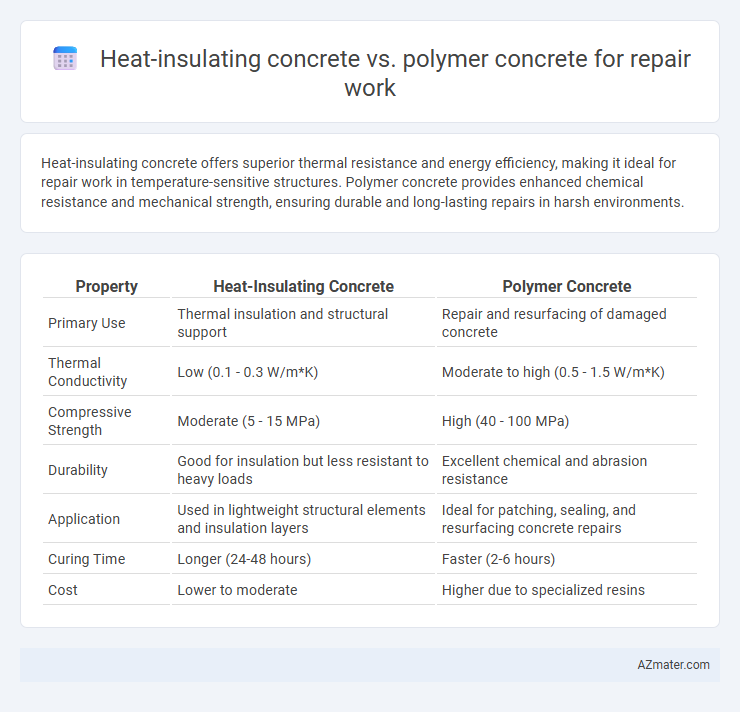Heat-insulating concrete offers superior thermal resistance and energy efficiency, making it ideal for repair work in temperature-sensitive structures. Polymer concrete provides enhanced chemical resistance and mechanical strength, ensuring durable and long-lasting repairs in harsh environments.
Table of Comparison
| Property | Heat-Insulating Concrete | Polymer Concrete |
|---|---|---|
| Primary Use | Thermal insulation and structural support | Repair and resurfacing of damaged concrete |
| Thermal Conductivity | Low (0.1 - 0.3 W/m*K) | Moderate to high (0.5 - 1.5 W/m*K) |
| Compressive Strength | Moderate (5 - 15 MPa) | High (40 - 100 MPa) |
| Durability | Good for insulation but less resistant to heavy loads | Excellent chemical and abrasion resistance |
| Application | Used in lightweight structural elements and insulation layers | Ideal for patching, sealing, and resurfacing concrete repairs |
| Curing Time | Longer (24-48 hours) | Faster (2-6 hours) |
| Cost | Lower to moderate | Higher due to specialized resins |
Introduction to Heat-Insulating and Polymer Concrete
Heat-insulating concrete is specifically formulated to provide thermal resistance and reduce heat transfer in structures, making it ideal for applications requiring energy efficiency and temperature control. Polymer concrete, composed of polymer binders combined with aggregates, offers superior chemical resistance, mechanical strength, and rapid curing properties, which are advantageous in repair work exposed to harsh environments. Selecting between heat-insulating and polymer concrete depends on the repair project's thermal insulation needs versus the demand for durability and fast setting times.
Key Properties of Heat-Insulating Concrete
Heat-insulating concrete offers superior thermal resistance with low thermal conductivity, making it ideal for repair work requiring enhanced energy efficiency. This concrete type typically possesses low density and high porosity, contributing to its lightweight nature and effective heat insulation. Its excellent fire resistance and moisture durability further ensure long-lasting performance in structural repairs exposed to varying environmental conditions.
Core Characteristics of Polymer Concrete
Polymer concrete offers superior chemical resistance and rapid curing times compared to heat-insulating concrete, making it ideal for repair work in harsh environments. Its high compressive strength and excellent adhesion properties ensure durable, long-lasting repairs even under heavy mechanical stress. Unlike heat-insulating concrete, polymer concrete is less porous and provides enhanced resistance to water infiltration and freeze-thaw cycles.
Application Areas in Repair Work
Heat-insulating concrete excels in repairing structures requiring thermal protection, such as building envelopes, industrial furnaces, and refrigerated facilities, where maintaining temperature stability is crucial. Polymer concrete is ideal for high-stress repair applications, including bridge decks, chemical containment areas, and wastewater treatment plants, due to its superior chemical resistance and rapid curing properties. Both materials address different repair needs: heat-insulating concrete focuses on thermal performance, while polymer concrete enhances durability and chemical resistance.
Thermal Performance Comparison
Heat-insulating concrete exhibits superior thermal resistance due to its composition with lightweight aggregates and insulating materials, significantly reducing heat transfer compared to standard concretes. Polymer concrete, while possessing enhanced chemical and mechanical durability, typically has lower thermal insulation properties because of its dense polymer matrix. For repair work emphasizing thermal performance, heat-insulating concrete offers more effective temperature regulation and energy efficiency.
Structural Strength and Durability Analysis
Heat-insulating concrete offers moderate structural strength with enhanced thermal resistance, making it suitable for repairs requiring temperature regulation but less ideal for heavy load-bearing applications. Polymer concrete exhibits superior structural strength and outstanding durability due to its dense polymer matrix, providing excellent resistance to chemical attack, moisture ingress, and mechanical wear. Comparative durability analyses highlight that polymer concrete outperforms heat-insulating concrete in long-term maintenance and structural resilience under harsh environmental conditions.
Installation and Workability Differences
Heat-insulating concrete offers superior fire resistance and thermal insulation but requires longer curing times and careful moisture control during installation. Polymer concrete cures rapidly with high early strength, enabling faster repair cycles and application in low temperatures, while maintaining excellent chemical resistance and adhesion. Workability in polymer concrete is generally enhanced by its thixotropic properties, making it easier to apply in vertical or overhead repairs compared to the heavier, often less flowable heat-insulating concrete mixtures.
Cost Considerations for Repair Projects
Heat-insulating concrete typically offers lower initial material costs compared to polymer concrete, making it favorable for budget-conscious repair projects. Polymer concrete, while more expensive upfront due to specialized resins and additives, provides superior durability and chemical resistance that can reduce long-term maintenance expenses. Evaluating the total cost of ownership for repair work involves balancing the cheaper installation of heat-insulating concrete against the extended lifespan and reduced repair frequency associated with polymer concrete.
Environmental Impact and Sustainability
Heat-insulating concrete reduces energy consumption in buildings by improving thermal efficiency, thereby lowering carbon emissions over the structure's lifecycle. Polymer concrete offers high durability and chemical resistance, extending repair lifespan and minimizing waste from frequent replacements. Both materials contribute to sustainability, but heat-insulating concrete emphasizes energy savings, while polymer concrete prioritizes material longevity and reduced environmental degradation.
Selecting the Optimal Concrete Type for Repairs
Heat-insulating concrete offers superior thermal resistance, making it ideal for repairs in environments requiring energy efficiency and temperature control. Polymer concrete provides enhanced chemical resistance and high mechanical strength, suitable for structural repairs exposed to harsh chemicals or heavy loads. Selecting the optimal concrete type depends on the repair context: prioritize heat-insulating concrete for thermal barriers and polymer concrete for durability and harsh exposure conditions.

Infographic: Heat-insulating concrete vs Polymer concrete for Repair work
 azmater.com
azmater.com